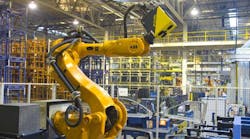As 2012 wraps up, we face that annual task of sorting through all of the year's news and events, its innovations and improvements, failures and successes, rises and falls to piece together the real story of the year and of all of its driving trends, so we'll know what to expect going into the next.
For manufacturing technology, though, that is no easy task.
There was no great recession in 2012, and it saw no moment of dramatic recovery or policy upheaval. There were no iPhone-moments, no black swans that changed our course or new software to change our ways.
However, at the close of the year, we are without question in a better place than we started. Manufacturing is expanding, the industrial economy is growing, the employment situation improving. One only has to look at the most recent manufacturing technology orders report to see the progress we've made.
In the post-IMTS surge, orders for these advanced tools skyrocketed with sales increasing 40% over the previous month, leading to a 5.6% increase over the previous year, setting the course for what might be the best year since we started keeping track.
This means, finishing out the year, more technology is being employed to bring higher quality, higher precision parts onto the market at a greater rate and with greater efficiency than ever before. It means machine tool builders are ramping up their production, parts makers gearing up theirs, to serve the needs of the OEMs for their expanding customer bases.
It’s difficult, however, to point to any single development or single event that brought us this improvement. Rather, it seems to be the cumulative result of a year's worth of isolated, incremental advances toward something vaguely and rather ominously referred to as "advanced manufacturing."
Defining the New Era
Advanced manufacturing is a big topic here at IndustryWeek, both from the high end perspective -- understanding its potential impact on the industry -- and the low -- trying to work out what the term even means. Of course, neither of these concerns -- maybe especially not the latter -- have yet been settled.
However, I did catch a glimpse of advanced manufacturing in action this year -- just the briefest view of what all of the disparate technologies of 2012 are creating in the industrial world -- all packed up neatly in the busy halls of IMTS.
Somewhere in those endless rows of machine tools, grinders, robots and software suites of McCormick Place, I was suddenly struck by how outrageously high-tech the industry had become. In that great throng of manufacturing technology, I felt for the first time that I was really in the midst of a new era of manufacturing, one in which "advanced" prefix finally made sense.
Today's machines are not the simple drills, mills and lathes of yesterday. They are complex and advanced, running axes numbered by the dozen, picking their own tools, feeding their own parts, blasting their bits with liquid nitrogen, some of them completely processing components from block to precision part in one set-up.
On the IT side, they carry operating systems capable of recording data on every rotation, every movement, every temperature hiccup or indication of future, otherwise undetectable error, to help them ramp up the productivity to unbelievable, space age heights.
It's hard not to look at these machines and be proud of the basic human ingenuity that made them possible, to be proud of the long history of machine tool technology that has resulted in these truly advanced tools.
It is also hard to look at them and not be totally intimidated by the complex engineering they require.
These are complicated machines. The options they present, their engineering flexibility, the impossibly complex programming involved, is just mind boggling. And that is a development that sits rather poorly next to another of 2012's biggest stories: the skilled labor shortage.
Skilled Labor in a High-Tech World
The year 2012 was plagued by constant discussion of issues, crises and speculation around skilled labor. According to the coverage to date, the baby boomer retirement sweep, the irresistible pull of Silicon Valley for our most capable engineers and the general slacking of STEM education might regress our industrial progress back to hand lathes and blacksmiths.
But a closer look at today's technology tells a different story.
The technologies proliferating in 2012 -- the tablets and smartphones, the real-time big data crunching software, the dashboard analytics and high-def GUIs -- have all cohered on the face of these new machine tools, providing more transparency to their operations and greater insight into its output than ever possible before.
The designers, meanwhile, have taken a lesson from the phones and tablets already in the hands of the workforce to make the controls from the high tech machine tools comparable in look, feel and intuitive architecture we are already accustomed to.
This has begun a fundamental shift in the role of the worker. Matching a workforce savvy with the technology of today to the advanced, multifunction tools of the trade transforms a normal operator tied to a single machine into a conductor perched on a podium, leading a symphony of manufacturing tools through their automated production cycles.
This is the takeaway from 2012 -- the real story our technological process has been trying to tell.
We are a high tech culture centered on an ever more high tech industry. Our tools have been designed to fit the natural skills and predilections of the new generation of workers, allowing them to finally work hand-in-(robotic)-hand, human and machine, to achieve the leanest, most efficient production the world has ever seen.
And that, to me, is advanced manufacturing -- an era 2012 has launched for us, which we will finally explore in 2013.
This story was originally published in the IMTS Insider.



